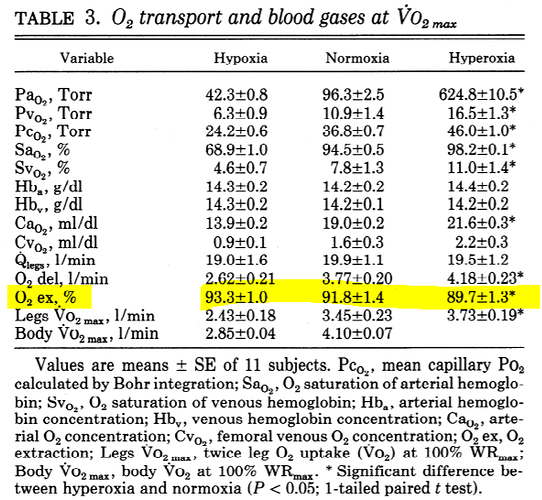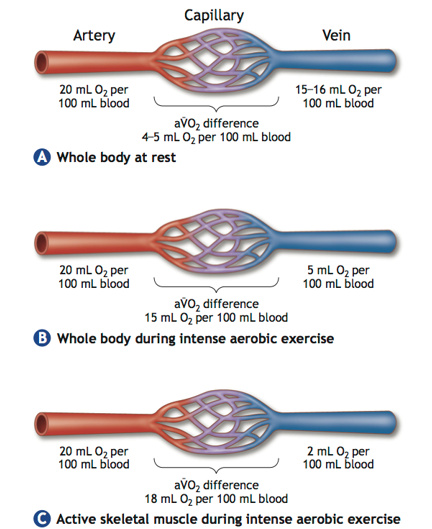It was Bora and maybe still is, if not it may account in some way for Sagans lack of form but it’s now Jumbo Visma
I don’t know. Maybe talent? Drugs? Luck? They don’t actually pay any attention to Weber? Who the heck knows.
What can be said is that he is dead-wrong about something that anybody who has ever taken an undergrad ex fizz class should understand. That makes me question every assertion he has ever made.
Obviously talent - you can’t make a silk purse out of a sow’s ear but Drugs and/or Luck?
Just pointing out that there are multiple alternative explanations for what you offered as “evidence”.
Maybe because the method works, but his idea of why it works is wrong.
I won’t be splitting hairs on what the term significant means for you and what not. I appreciate the post, though ![]()
No need to split hairs, the data are clear: at VO2max, roughly 90% of the oxygen in arterial blood has been extracted by the exercising muscles, i.e., only about 10% remains.
Here is an example from 11 healthy, moderately-fit young men studied in hypoxia, normoxia, and hyperoxia. As highlighted, oxygen extraction is around 90% under all three conditions.
Please feel free to transfer insignificant 10% of your salary to me ![]()
All $1200 is yours. Where should I send it?
@empiricalcycling already alluded to this. The arteriovenous O2 difference is greater when measured across the exercising limbs compared to that measured across the whole body. That’s because even during maximal exercise, some blood is being sent to tissues (e.g., kidneys, skin) that don’t extract nearly as much O2 as the exercising muscles themselves.
IOW, venous O2 content is higher when measured in the pulmonary artery versus, e.g., the femoral vein because the former is “contaminated” with relatively O2-rich blood.
ETA: Here is the figure from McArdle, Katch, and Katch corresponding to one you found online.
![]() I love this forum!
I love this forum!
Sorry, seeing this a bit late, but interesting conversation. Hope I can still contribute.
Very general suggested explanation: that’s where most of the metabolic activity is occurring, ie. the greatest disruption to metabolic milieu, and subsequently the greatest signals back to your brain that “something is wrong down there” ![]() =
= ![]()
I haven’t seen much investigation into why or when someone might feel leg-limited vs breathing-limited. Would be interested if anyone else has. But I was surprised to see how much variability TR users were reporting in that other thread a while ago.
This adds to the greater point about local vs systemic a-vO2 differences. The microvasculature closest to/within the tissues where O2 is being utilized will obviously have greater O2 extraction and greater a-vO2 diff than tissues further away. If femoral vein a-vO2 diff is ~90%, I would guess that approaches 100% within the microvasculature, before ‘contamination’ from other less metabolically active tissues being drained into the femoral vein. eg. blood volume coming from skin and fat tissue, which is mostly still oxygenated.
I’m with you here. VLamax is a very convenient tool that appears to quantify phenotype well. But I’m skeptical how literally true or at least relevant the VLa measurement is to anything.
It’s up to us though to build on the VLamax model and/or make something that works better in the lab and on the road. Not just tear it down and walk away, IMO.
This isn’t what’s happening here. I’d love to admit that it were but if we take this mistake as true, then it has training implications that will not be borne out as effective. Oh right, and are not borne out by even the most basic understanding of the literature.
The book is just as cryptic. I was really disappointed by it. Grady appears to have some interesting ideas, but the book is poorly structured and lacks any real practical takeaways, IMHO.
100% agree. It’s like she only wrote half of it. It has some great explanations and ideas in. Then just ends before you have anything actionable that you can do. It’s all held back.
It’s like an advertisement to her coaching.
@Mikael_Eriksson To revive this old thread as I continuously come back to it… After some year now and a lot more experience… How do you think about these concept? Are you still categorizing training in VO2Max and VlaMax or is your “philosophy” more nuanced than that or maybe even simpler? Dan Lorang still seems to use this philosophy with great success.
As a recently self coached athlete for myself I believe in threshold work on the run and doing more work above threshold on the bike and rather race-specific in the swim. So currently in a VO2Max block where I still do (upper) threshold on the run as I think high intensity on the run is just not enough bang for the buck. But probably would make sense to intermix a VO2Max block after ~4-5 weeks with ~2 weeks of threshold work? Like some strength endurance and sweetspot work on the bike then going back into another ~4 weeks block of VO2Max? Anecdotally it has felt like threshold or also lactate clearance work have “solidified” gains in the VO2Max area into the threshold if that makes sense?
Anyway, I’d love an updated perspective here from you ![]()
I seem to recall that he no longer uses Insycd testing. I believe there are comments to be found on twitter if you search for vlamax.
My take is that the whole vlamax thing is a red herring and in the end, the Inscyd test is just an expensive power profile.
VLaMax is an interesting topic. I spent a long time trying to understand Mader and his model. I’m still I’m still trying to understand.
What I noticed from more than a dozen VLaMax tests in both running and cycling is that there’s a max lactate concentration associated with ending an effort for me. Whether it’s a 15 second effort or a 10 minute time trial, I’ll start around 1.0mmol/l and fail around 9-9.5 mmol/l, so about 8-8.5 delta.
But I can get my lactate concentration up to 16-18 mmol/l with repeated sprints before I give up completely. So for a single effort, there’s a lactate ceiling…a maximum lactate production. But at this point I’m not sure how to use that info.
That would be a maximal blood lactate concentration, not a maximal rate of lactate production.



